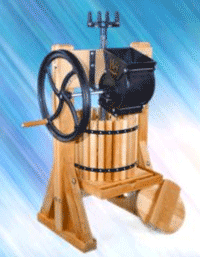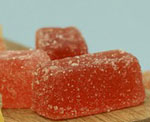Vinegar Making
has its own benefits:
"It's practical, inexpensive and easy to do!"
Cider vinegar making at home has been practiced since the olden days and has continued right up to the present time. The resulting homemade apple cider vinegar is likely to be healthier and better tasting than most commercially produced vinegars.
The fastest way to produce homemade apple cider vinegar is to start with a hard cider that has already been completely fermented (no sugar left) to an alcohol content of 5 to 6 %.
Using the natural bacteria (acetobacter) present in the air, the alcohol can be transformed into vinegar (acetic acid) under suitable conditions.
This vinegar making process will take about 2 months to complete, and at the bottom of this page you will find a step-by-step procedure for doing just that.
If you do not have any hard cider available, then you will have to start by making your own hard cider from freshly pressed apple juice, which is additive free and has not been pasteurized.
This type of juice is readily available from your local apple orchard in late September and October, and can be frozen for use throughout the year.
A simple
Hydrometer
is recommended to determine if there is enough natural sugar in the juice to make a hard cider with an alcohol content of 5 to 6%.
For a traditional vinegar making procedure starting from apple juice, click here.
| click on any of the pictures or the links to Amazon. I will earn a small commission, at no cost to you. |
For those fortunate enough to have their own supply of apples, preferably organically grown,
 you will need milling and pressing equipment to extract the juice before fermenting it to hard apple cider.
you will need milling and pressing equipment to extract the juice before fermenting it to hard apple cider.
However, by vinegar making from scratch, you will have the most control over the flavor of the resulting homemade apple cider vinegar since it is a blend of several different types of apples that makes the most flavorful product.
An excellent home Pioneer Cider Press & Grinder ![]() unit, that can be purchased online, is shown to the right.
unit, that can be purchased online, is shown to the right.
It's been made, along with 5 other types of fruit presses, for over 25 years in Kansas, USA by the folks at Happy Valley Ranch.
If you are dealing with just 1 or 2 apple trees, then smaller more portable apple grinding and pressing units, as shown below, would be more practical.
For a lot more in depth information on how to make a great hard cider from scratch, Andrew Lea has written a must read book called Craft Cider Making. Click on the link below to review or purchase this book online.
Vinegar Making
Starting from Hard Apple Cider
- Fill a thoroughly cleaned wide-mouthed glass jar (a 700 ml mason jar will due fine) with about 500 ml of 5 to 6% hard apple cider.
- Add 50 ml of unpasteurized and unfiltered organic apple cider vinegar which contains some mother of vinegar (Available at most health food stores).This will quick-start the vinegar making process.
- Cover the jar top with two layers of cheesecloth, this will allow vinegar bacteria and oxygen from the air to get to the surface of the cider without being contaminated with fruit flies and other pests.
- Place the jar in a warm room but in a dark place away from sunlight, which will interfere with the action of the bacteria. The optimum temperature for vinegar making is about 29 degrees C (85 F).
- After about 2 weeks there will be a gelatinous white film floating on top of the liquid, this is the mother of vinegar, which is produced by the vinegar bacteria as it converts the alcohol into vinegar (acetic acid).
- Allow the reaction to proceed for at least 4 to 8 weeks, then, if you started with a hard cider with 6% alcohol content, you should have a vinegar with about 5% acetic acid.
- The age-old method for determining if the vinegar is complete is to simply smell and taste it. No odor or flavor of alcohol should be present.
- A far more accurate way is to measure the acid content by titration. Inexpensive titration kits can be found at your local wine and beer making shop and are easy to use.
- Click here for information on doing a vinegar titration.
- Once completed, store the apple cider vinegar into clean long necked glass containers
equipped with plastic screw-type caps, and discard the thick mother of vinegar film or reuse it to start-up a new batch.






